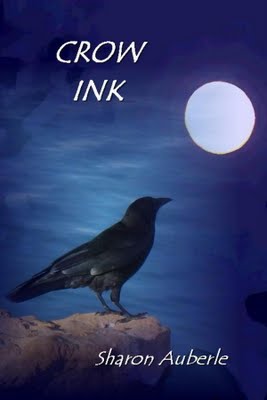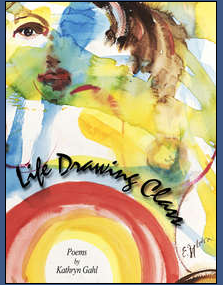Book Review
Saturday Nights at the Crystal Ball by Sharon Auberle. Ellison Bay, WI: Cross+Roads Press, 2008. $12. http://www.norbertblei.com/code/crossroads.asp
Crow Ink by Sharon Auberle. Baileys Harbor, WI: Little Eagle Press, 2009. $15. http://lileaglecrowink.blogspot.com/
Life Drawing Class: Poems by Kathryn Gahl. Two Rivers, WI: The Cottage Corollary, 2009. $22. http://www.kathryngahl.com/index.htm
Reviewed by Russell Gardner, Jr.
I feel honored to have read, contemplated and now reviewed three books by two distinguished poets who frequent the Lake Michigan shore part of Wisconsin. These three sets of poems—each quite different from the other—possess distinct narratives of their own, especially Saturday Nights at the Crystal Ball by Sharon Auberle and Kathryn Gahl’s Life Drawing Class, this last named for the initial poem in the collection. That being the case and coming from a family that disapproves of plot give-aways, I’ll tread with care on dramatic storylines, except to say that they exist for both, though I will say that Saturday Nights deals with dancing as you may have already guessed, and Life Drawing gives hints of its story in Gahl’s dedication that I replicate below.
Auberle’s Crow Ink speaks to the blacks and whites of crow imagery, with a picture of one dark bird on the front in black perched on a rock (with a white moon), and one on the back in white with an even whiter moon surrounded by a textured white about the edges that to me feel like leaves. This dramatic glossy paperback cover likely fostered my buying it at the Oconomowoc Wisconsin Fellowship of Poets meeting earlier this year; likewise Saturday Nights, which features a couple dancing in a photograph that uses reversed white-dark polarities, so that we see “the negative,” a telling visual metaphor. Had I happened to view it, I doubtless would have acquired Gahl’s book too, as a reproduced watercolor of Bert Zylstra graces its cover with compelling force, especially with an artfully placed eye in the upper left corner. Gahl’s dedication reads “For Bert Zylstra (1940-2000) & for Robert, for everything.” There’s a story there, as I mentioned above, but I’ll let you discover it for yourself. Story interweaves story in Crow Ink too, as it weaves its way into your mind and heart, but more subtly, as early winter trees sometimes do the sky at night.
Both of these feeling-filled poets have lived life fully and combine visual art with well-wrought words. (Full disclosure: I double as a mixed media artist as well as poet so I may especially respond to such). Zylstra’s four additional arresting fragments of probably larger pictures divide the interior of Gahl’s book into “Line,” “Shape,” “Shadow,” and “Light.” I felt reminded of the “color-shock” concept for interpreting Rorshach cards in that Zylstra’s vivid watercolor arrested my attention, even momentarily disorganized my experience of Gahl’s poems, but, as with accommodating to a brighter light, illuminated my reading.
Auberle’s two books do most interesting things with visual imagery as well; she herself does visual art and word-work. In Saturday Night, she typically uses old photos as well as seeming replications of ‘on-the-spot notes’ done at emotional times, the tension-releasing doodlings usually ordinary but here expressive and affecting. I found these especially compelling, having had a parallel experience to the one that provides her dramatic story line. She plays with meaning, form, symbols, composition and likely color as well. The books’ interiors are limited to black, white and gray tones. Auberle even uses the same image in both collections but with slightly different treatment (compare page 53 in Saturday Nights to page 83 of Crow Ink). In the way that one learns familiar symbols in another’s life, I enjoyed the recurrent memory in a new context, all the richer for that.
Both Auberle and Gahl excel at word-imagery as well, telling of insecurities, sadness, defiance, distress, and mortality. They both employ vivid metaphor. I’ll illustrate with two quotes, first from Kathryn Gahl writing about her ‘day job’:
The reason nurses write
mostly poetry …is because nurses revolve in systems,
each spin part of a process
diagrammed like a sentence ….… a nurse hurries to convert heart sounds
and hard words into art before the next patient
arrives, hemorrhaging, counting on that nurse
to flow like a pen, bleeding for them both.
And near the end of Crow Ink, Sharon Auberle tells us “Some Things You Must Do,” including the following that remind us in Wisconsin of our beneficial boundaries on three sides by great bodies of water:
find a dead end road, a small beach
at the end of it, lie on sun-warmed rocks
drink in the day, the lake
the fine wine of a summer afternoon
laugh, listen to the music
of beach and sky and wind …savor …
for as deep and forever as you can.
The two poets differ considerably: Gahl lives a vibrant, socially connected life, as signaled by the colorful Zystra watercolors that coordinate with her poems to provide us line (e.g.,farm kid, sexual experience), shape (e.g, why a poet), shadow (e.g., harsh criticism), and light (e.g, the answer to what/how a person chooses artistic expression). Auberle tells us her contemplative experience and shares it with us in a subtle, black-gray-white fashion, extending to us her symbol worlds familiar from meditative experience, eastern tradition, juxtapositions, and discovered art (e.g., scarrings on white birch bark from long ago penknives). Both craft words engagingly. Both fundamentally live and express their lives as artistic works, benefiting their families and acquaintances, as well as their readers.
Russell Gardner, Jr. grew up on a central WI farm, lived in many states as an adult, and is back in Wisconsin. Writing poetry (and prose) since college, he also does mixed media visual art and helped originate and then coordinate the Epidemic Peace Imagery project featured in Free Verse #99/100. Gardner's poem ""Edgeworks Number 1" appears in Verse Wisconsin magazine.




